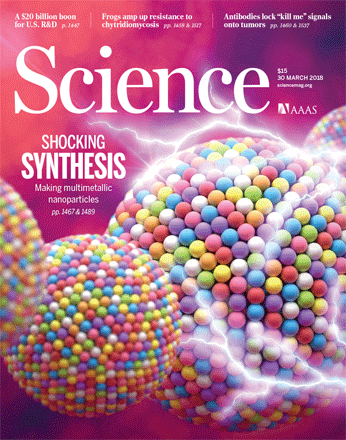 |
New method for the preparation of previously-unattainable alloys was developed by Prof. LiangBing Hu and collaborators. Read the full story here. |
From the Samurai sword to the steel I-beam to the coils of an electromagnet, metals are part of our past, present and future.
Metals are characterized by malleability, ductility, high electrical and thermal conductivity and a shiny surface that reflects light. Metallic bonding where valence electrons are shared by the entire solid gives rise to the "free" electrons responsible for the metallic electrical, thermal and optical properties.
Did you know? The vast majority of chemical elements in the periodic table are metals.
Elemental metals have shortcomings that limit their utility. Materials scientists and engineers make superior metals, often by alloying (mixing elements).
Practical engineering applications - Out of the vast number of alloys, and using appropriate processing techniques, scientists identify alloys that are tougher, lighter, and most inert for engineering applications; for example: for the construction of skyscrapers, bridges, airplanes and submarines.
Pioneering Materials Science and Engineering @ the University of Maryland
 |
New method for the preparation of previously-unattainable alloys was developed by Prof. LiangBing Hu and collaborators. Read the full story here. |
Prof. Manfred Wuttig and colleagues at the University of Kiel, Germany developed a shape memory alloy that can withstand millions of cycles of stress and heat without showing fatigue. This make the technology suitable for artificial heart valves and flapping wings. Read the full story here.
Link to Science Magazine article here.
Link to BBC report here.
Prof. Salamanca-Riba leads the development of a manufacturing technique that incorporates graphene into aluminum and copper. The resulting composite materials, called "covetics", have better electrical, mechanical and thermal properties than their parent metal. Covetics have the potential to improve energy efficiency in power transmission lines and device interconnects, among other applications. Read the full story here.
Prof. Oded Rabin and his research team use silver cubes 100 nanometers (1/10000th of a millimeter) in size to detect molecules. With the cubes, signal can be identified with just ten thousand molecules. Without the nanocubes, ten billion molecules would be needed. Read the full story here.
Link to ACS Nano article here.
Link to Prof. Rabin's Laboratory webpage.
Embark on an exciting career by enrolling in the B.Sc., M.Sc. or Ph.D. programs of the Department of Materials Science and Engineering, and you can take part in advancing the field of Materials. All students are provided opportunities to join research teams and perform laboratory work in the area of their interest.
Learn about our undergraduate program here.
Learn about our graduate program here.
| Ankem | Hu | Rabin |
| Salamanca-Riba | Wuttig | Zhao |
Most metal alloys are highly crystalline, which is key to their ability to deform plastically and to resist failure under repeated mechanical loading—good examples of this are the alloys used in aircrafts that can compensate for deformation in high-speed flight, or bridges designed to bend in the wind.
Did you know? Materials scientists use rapid solidification to make amorphous (non-crystalline) metals, known as metallic glasses. They are remarkably hard, brittle and electrically conductive.
Break Time — MSE @ UMD Media center
In this example, the amorphous metal formed by combining 5 different atoms together: zirconium, titanium, copper, nickel, and beryllium (Zr41.2Be22.5Ti13.8Cu12.5Ni10.0). The differing atomic diameters of these elements and the unusual composition of the alloy prevent the atoms from arranging in a regular crystalline structure. The atoms have no easy way to slip by each other under deformation, resulting in a very hard material. When a steel ball bearing is dropped on the amorphous metal, the ball bounces many times before coming to rest. The metallic glass does not permanently deform upon impact, and as a result the ball bearing retains its energy for a longer time.
In this example, the wire is made of Nitinol, a nickel-titanium alloy. Shape memory materials experience a solid state phase change, in which atoms are rearranged, but the material remains a solid. In the low temperature phase, the material can respond to mechanical forces by slightly shifting the positions of the atoms relative to each other. When that happens we observe the material deform. In the high temperature phase, those shifts are not possible; therefore, upon heating, the atoms return to their original positions, and we observe the recovery of the shape of the material.
MSE goes beyond improving the common properties of metals, to finding uncommon behavior. For example, the characteristics of Nitinol, a metal alloy of titanium and nickel, include:
The tools of metalworking depend on whether the object features are meters, millimeters or nanometers in size. When approaching the nanometer scale, in which electrons behave like waves and surface effects are important, metallic objects acquire intriguing properties. For instance, metal nanoparticles scatter light intensely, making them look much larger than they really are! Spherical silver nanoparticles make water look bright yellow and gold nanoparticles turn it burgundy. These new optical properties are interesting for sensing and communication technologies.
Learn more about Nanotechnology and MSEVisit the NanoCenterBack to "What is MSE?"Practical Info for Prospective Students